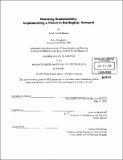| dc.contributor.advisor | John de Monchaux. | en_US |
| dc.contributor.author | Maslan, Noah Terrell, 1974- | en_US |
| dc.contributor.other | Massachusetts Institute of Technology. Dept. of Urban Studies and Planning. | en_US |
| dc.coverage.spatial | n-us-vt | en_US |
| dc.date.accessioned | 2006-02-02T18:48:06Z | |
| dc.date.available | 2006-02-02T18:48:06Z | |
| dc.date.copyright | 2001 | en_US |
| dc.date.issued | 2001 | en_US |
| dc.identifier.uri | http://hdl.handle.net/1721.1/31100 | |
| dc.description | Thesis (M.C.P.)--Massachusetts Institute of Technology, Dept. of Urban Studies and Planning, 2001. | en_US |
| dc.description | Includes bibliographical references (p. [97]-102). | en_US |
| dc.description.abstract | Sprawling growth patterns have characterized the spatial development of cities in the United States since the advent of the automobile. Extensive research has shown that low-density, haphazard development (a.k.a. sprawl) causes numerous deleterious impacts on communities. Communities are beginning to recognize the consequences of sprawling development patterns and wish to shift those patterns to more sustainable land-use, economics, ecologies, human settlements, and human relationships. Although efforts at all levels are being made to slow down sprawl, low-density suburbs are built in place of new development or redevelopment near existing infrastructure in central cities. Even in rural Vermont, sprawl threatens the unique village centers surrounded by breathtaking working landscapes that Vermonters cherish and visitors flock to. Burlington, Vermont recognizes that sprawl is degrading the natural landscape. As part of a promulgated vision of sustainability in municipal plans, Burlington accepts their role as a regional growth center. Compact mixed-use development patterns are identified as the type of urban form commensurate with curbing sprawl. Burlington designated certain growth centers within the city and is attempting to increase density in those areas. This thesis explores the types of local land-use tools Burlington is uses to focus development in designated parts of the city, as one aspect of a sustainable growth strategy. The case study reveals that residents oppose higher density projects due to a perceived threat to their pervading quality of life. However, people do not have an innate awareness and understanding of what design elements contribute to the quality of their built environment. Since urban design and architecture determine the quality and character of compact development and compact development is essential to curb sprawl, then good urban design and architecture are critical components in curbing sprawl. In order for higher density projects to gain acceptance, the methods of analysis used for development review need to shift to more qualitative measures based on the type of site design and architectural features that communities prefer. | en_US |
| dc.description.statementofresponsibility | by Noah Terrell Maslan. | en_US |
| dc.format.extent | 102 p. | en_US |
| dc.format.extent | 7754362 bytes | |
| dc.format.extent | 7766523 bytes | |
| dc.format.mimetype | application/pdf | |
| dc.format.mimetype | application/pdf | |
| dc.language.iso | eng | en_US |
| dc.publisher | Massachusetts Institute of Technology | en_US |
| dc.rights | M.I.T. theses are protected by copyright. They may be viewed from this source for any purpose, but reproduction or distribution in any format is prohibited without written permission. See provided URL for inquiries about permission. | en_US |
| dc.rights.uri | http://dspace.mit.edu/handle/1721.1/7582 | |
| dc.subject | Urban Studies and Planning. | en_US |
| dc.title | Realizing sustainability : implementing a vision in Burlington, Vermont | en_US |
| dc.type | Thesis | en_US |
| dc.description.degree | M.C.P. | en_US |
| dc.contributor.department | Massachusetts Institute of Technology. Department of Urban Studies and Planning | |
| dc.identifier.oclc | 49734105 | en_US |
